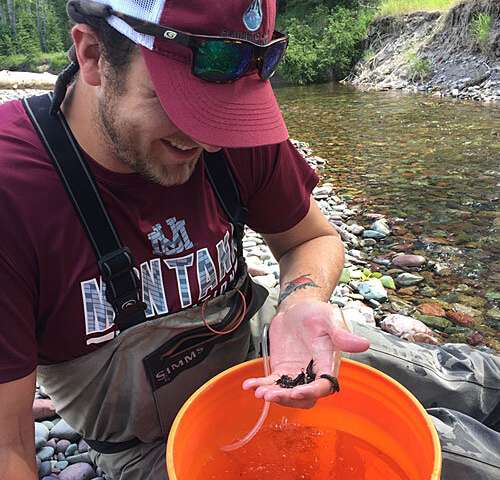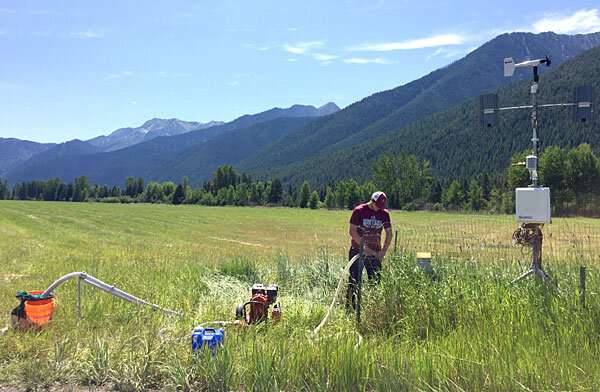#Researchers unlock mystery of subterranean stoneflies
“#Researchers unlock mystery of subterranean stoneflies”

In a new study published in the scientific journal Ecology, researchers from the University of Montana’s Flathead Lake Biological Station may have unlocked a mystery surrounding unique aquatic insects in the Flathead watershed.
“There’s a surprising adaptation of stoneflies in alluvial aquifers that allows them to use low-oxygen or oxygen-free environments,” said FLBS researcher Rachel Malison, lead author on the study. “These aquifers are hotspots of biodiversity, and this study highlights the vital role gravel-bed river floodplains play on the landscape.”
River floodplains are among the most biodiverse landscapes on earth. They provide an important habitat for aquatic and terrestrial organisms, and their aquifers (i.e., shallow groundwater beneath and adjacent to the river) are key components of complex ecosystems worldwide. The Nyack floodplain of the Middle Fork Flathead River outside Glacier National Park, for instance, sustains everything from microbes to grizzly bears and is home to over half of the 100-plus species of stoneflies known in the state of Montana.
But there’s a unique mystery at work within these river floodplains. Out of sight and under the surface, alluvial aquifers are composed of unconsolidated materials and offer limited sources of carbon for sustaining organisms and food webs. Alluvial aquifers also can contain extreme environmental conditions and an abundance of methane gas, which is typically produced in freshwater ecosystems within anoxic (zero-oxygen) or hypoxic (significantly low-oxygen) environments.
To this point, most stoneflies are thought to require highly oxygenated water environments to survive. But in the alluvial aquifer of the Nyack floodplain, large populations of subterranean stoneflies exist that can be found in low-oxygen environments, and significant portions of their biomass carbon derive from methane.
The question of how these stoneflies could survive and possibly access food in such an inhospitable, low-oxygen environment, is a question that Malison and her team of researchers set out to address.

“It was in the early-1990s that [FLBS researcher] Bonnie Ellis first discovered that a species of stonefly in the Nyack floodplain had the ability to survive anoxia exposure, and it’s been a mystery ever since,” Malison said. “No other stoneflies have this adaptation, so we wanted to investigate to better understand how large populations of stoneflies might be supported in aquifer food webs.”
Through the course of their study, Malison and her fellow researchers tested the anoxic and hypoxic responses of nearly 2,500 stonefly individuals in three alluvial aquifer species and nine river species. Compared to their surface-dwelling relatives, the aquifer stoneflies performed better in low-oxygen and oxygen-free conditions, surviving an average of three times longer than their above-ground counterparts.
Additionally, the aquifer stoneflies were still able to keep moving and crawling when exposed to 76 hours without oxygen, which has important implications for how these species may be able to access different food resources in the aquifer.
Delving into the DNA of the stoneflies, the researchers showed that the aquifer stoneflies have gene sequences for hemocyanin, an oxygen-transport respiratory protein, which could represent a possible mechanism for the stoneflies’ ability to survive at low-oxygen levels.
The results of the study show that subterranean stoneflies likely are able to exploit rich carbon resources in anoxic zones, which may explain their extraordinarily high abundance in gravel-bed floodplain aquifers. Additionally, their remarkable ability to perform well in low-oxygen and oxygen-free conditions is unique within the entire order of stoneflies.
It’s a discovery that suggests unconventional and surprising methane sources likely support a crucial component of biodiversity and productivity in floodplains all over the world.
“These findings begin to help us understand how vulnerable different stoneflies might be to climate change,” Malison said. “As waters warm they contain less oxygen, potentially causing stress and negatively influencing populations of the more sensitive species.”
More information:
Rachel L. Malison et al, Remarkable anoxia tolerance by stoneflies from a floodplain aquifer, Ecology (2020). DOI: 10.1002/ecy.3127
Researchers unlock mystery of subterranean stoneflies (2020, July 1)
retrieved 1 July 2020
from https://phys.org/news/2020-07-mystery-subterranean-stoneflies.html
This document is subject to copyright. Apart from any fair dealing for the purpose of private study or research, no
part may be reproduced without the written permission. The content is provided for information purposes only.
If you want to read more Like this articles, you can visit our Science category.
if you want to watch Movies or Tv Shows go to Dizi.BuradaBiliyorum.Com for forums sites go to Forum.BuradaBiliyorum.Com




